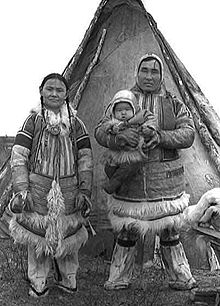
Back شعب نغاناسان Arabic شعب نجاناسان ARZ Nqanasanlar Azerbaijani نقاناسانها AZB Нганасаны Byelorussian Нганасани Bulgarian Nganasanere Danish Nganasanen German Pueblo nganasan Spanish Nganassaanid Estonian
ӈәнә"са (нә"), ня" | |
|---|---|
 Nganasans, 1927 | |
| Total population | |
| c. 978 (2002) | |
| Regions with significant populations | |
| 834 (2002) | |
| 44 (2001)[1] | |
| Languages | |
| Nganasan language, Russian language | |
| Religion | |
| Animism, Shamanism, Orthodox Christianity | |
| Related ethnic groups | |
| Selkups, Enets, Nenets, other Uralic peoples | |
The Nganasans (/əŋˈɡænəsæn/ əng-GAN-ə-san; Nganasan: ӈәнә"са(нә") ŋənəhsa(nəh), ня(") ńæh) are a Uralic people of the Samoyedic branch native to the Taymyr Peninsula in north Siberia. In the Russian Federation, they are recognized as one of the indigenous peoples of the Russian North. They reside primarily in the settlements of Ust-Avam, Volochanka, and Novaya in the Taymyrsky Dolgano-Nenetsky District of Krasnoyarsk Krai, with smaller populations residing in the towns of Dudinka and Norilsk as well.[2]
The Nganasans are thought to be the direct descendants of proto-Uralic peoples.[3] However there is some evidence that they absorbed a local Paleo-Siberian population. The Nganasans were traditionally a semi-nomadic people whose main form of subsistence was wild reindeer hunting, in contrast to the Nenets, who herded reindeer. Beginning in the early 17th century, the Nganasans were subjected to the yasak system of Czarist Russia. They lived relatively independently, until the 1970s, when they were settled in the villages they live in today, which are at the southern edges of the Nganasans' historical nomadic routes.
There is no certainty as to the exact number of Nganasans living in Russia today. The 2002 Russian census counted 862 Nganasans living in Russia, 766 of whom lived in the former Taymyr Autonomous Okrug.[4] However, those who study the Nganasan estimate their population to comprise approximately 1000 people.[a] Historically, the Nganasan language and a Taymyr Pidgin Russian<ref">Stern (2005)</ref> were the only languages spoken among the Nganasan, but with increased education and village settlement, Russian has become the first language of many Nganasans. Some Nganasans live in villages with a Dolgan majority, such as Ust-Avam. The Nganasan language is considered seriously endangered and it is estimated that at most 500 of the Nganasan can still speak it, with very limited proficiency among those 18 and younger.[8]
- ^ a b State statistics committee of Ukraine - National composition of population, 2001 census (Ukrainian)
- ^ Ziker
- ^ Lamnidis, Thiseas C.; Majander, Kerttu; Jeong, Choongwon; Salmela, Elina; Wessman, Anna; Moiseyev, Vyacheslav; Khartanovich, Valery; Balanovsky, Oleg; Ongyerth, Matthias; Weihmann, Antje; Sajantila, Antti (27 November 2018). "Ancient Fennoscandian genomes reveal origin and spread of Siberian ancestry in Europe". Nature Communications. 9 (1): 5018. Bibcode:2018NatCo...9.5018L. doi:10.1038/s41467-018-07483-5. ISSN 2041-1723. PMC 6258758. PMID 30479341.
- ^ "Центральная База Статистических Данных". Archived from the original on 12 April 2008.
- ^ Ziker (1998)
- ^ Ziker (2002)
- ^ Ziker (2010)
- ^ Janhunen, Juha. http://www.helsinki.fi/~tasalmin/nasia_report.html#Nganasan
Cite error: There are <ref group=lower-alpha> tags or {{efn}} templates on this page, but the references will not show without a {{reflist|group=lower-alpha}} template or {{notelist}} template (see the help page).
© MMXXIII Rich X Search. We shall prevail. All rights reserved. Rich X Search